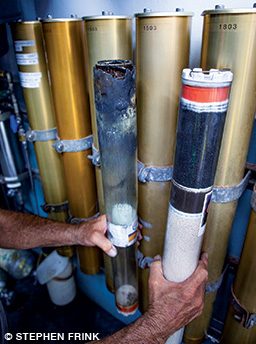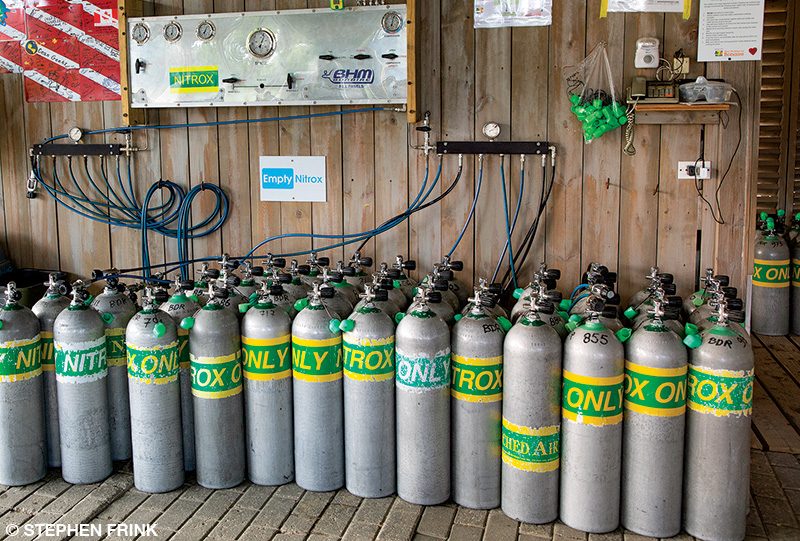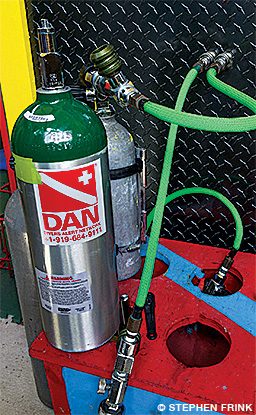What are safe levels in our breathing air at depth?

Research has described the effects on human health of elevated partial pressures of carbon monoxide (CO) and carbon dioxide (CO2) while diving, but only occupational health and safety studies have covered solids such as oil mist and particulate matter suspended in air and only in terms of breathing at the surface.1 The difference between the U.S. Compressed Gas Association (CGA) recommendations and the European standards for CO and CO2 limits2 is small, but it is much larger for oil content. Regardless of regulatory limits, we should ensure we are safe while enjoying our recreational dives.
The limit for oil appears in almost every published compressed-air specification, whether it be condensed oil, oil mist, mineral oil or synthetic oil. Some specifications, however, combine both oil and particulate matter into one limit; others do not specify any limit for particulates. Why is this, and what is the common element of concern? Both contaminants are fire and health hazards, are considered solids (noncompressible matter) and are difficult to separate for analysis.
The following is an overview of the basic concepts:
- Depth has a direct impact on partial pressure. According to Dalton’s law, the deeper we dive, the higher the partial pressure of all the breathing gas’s constituents (separate gases that make up the air we breathe).
- There is no partial pressure of oil mist or particulate matter, but the effect is the same. We instead need to consider the number of molecules of the substance in a unit volume. As with the surface equivalent value (SEV) discussed in our article about CO2, the amount of oil in each breath will increase as depth increases and gas compresses. If your cylinder has a gas mix containing a concentration of 1 milligram per cubic meter (mg/m3) of condensed oil and you used it on your dive to 130 feet of seawater (fsw) — 40 meters of seawater (msw) or 5 atmospheres absolute (ATA) — the amount of oil in each breath would rise to five times the surface value.
- Producing nitrox using a membrane separator will reduce both oil and particulates because their molecules are much larger than those of all the gases. We measure the effective diameter of all particulate matter in microns and the diameters of gas molecules (and membrane fibers) in angstroms, which are tens of thousands of times smaller.
- When the appropriate compressor oil and filters are in place and when an assessment of the surrounding area ensures that no obvious sources of hazardous pollution could be drawn into the compressor, the gas in a filled cylinder should not contain any toxic substances.
- The two risks of oil and particulates are their effects on the respiratory system and the risk of fire.
- The elevated partial pressure of oxygen at depth has no discernable effect on respiratory issues from particulates, but the risk of fire increases with use of oxygen-enriched gases.
- The analysis of oil and particulates is an additional complication. Gas-detector tubes and other similar mechanical devices appear to be ineffective in detecting particulates. Laboratory analysis provides a good degree of accuracy but requires sending a sample, so it is a time- and money-intensive spot check. Several volatile organic compound (VOC) analyzers are available for real-time monitoring of contaminant levels, but the user must know the constituents of the type of oil used, which few compressor oil producers provide in their datasheets. It is important to note that we measure a VOC as a gas and not a particulate or liquid.
- If we need to know the concentration in parts per million (ppm),3 then we need to consider ppm by weight (ppmwt). In this case, mg/m3 almost relates to the same value of ppmwt.
- While breathing-air compressor oils must be human-safe (nontoxic), the compressor requires proper maintenance and running state. An overheated compressor can easily burn the oil regardless of the type. Combustion implies the production of CO — the “silent killer.” Published cases have confirmed CO toxicity resulting from overheated compressors.
Health Issues
Particulate matter such as dust, metal particles and oil particulates can cause respiratory issues for divers, especially those with an existing respiratory weakness.
Most people are aware of the hypoxia hazards from smoke but perhaps not the hazards unrelated to CO, CO2 or other combustion products. The environmental agencies that determine these hazards compute and publish them in terms of particulate limits. The U.S. Environmental Protection Agency (EPA)4 describes the health effects of particulate matter in terms of size in microns (µm)5 and concentration in micrograms per cubic meter (µg/m3). Concentration values are in two sizes: 2.5 µm (PM2.5) and 10 µm (PM10), determined over 24 hours. Researchers then correlate these values with population health effects to produce a result in a range from good to hazardous. When compared with breathing-air quality standards that regulate particles, these limits are orders of magnitude higher than those allowed in compressed breathing air — even when accounting for the effects of depth.6
Compressed-breathing-air standards cover the concentration of combined oil and other particulates, and the dive industry has generally adopted these standards. The essential issue is the sizes of the particulates. The EPA categorizes particulates as PM2.5 and PM10, but compressed-breathing-air standards categorize them as those larger than or smaller than approximately 5 µm. The actual size is less important than the observed effect around this size.

Particles smaller than 5 µm tend to lodge in the deep recesses of the lungs, hindering the passage (exchange) of gases and resulting in hypoxia. The effect is cumulative: The longer the exposure during the dive, the greater the concentration at the end of the dive. The body can get rid of these particles, but it takes time. Particles larger than 5 µm tend to cause upper respiratory tract issues such as irritation and inflammation.
A properly maintained compressor and breathing-air filtration system will remove the larger particles. The inlet filter to the first-stage regulator will typically have a 5 µm sintered filter, so it is unlikely that a diver will have respiratory tract issues due to large particulates unless there is a mechanical breakdown.
Particles smaller than 5 µm that pass through the sintered filter in the first-stage regulator can cause lung irritation and inflammation, which is sometimes referred to as chemical pneumonia — although the particles, including oil, are not chemically toxic.
While these small particles are not individually visible, it is possible to see an accumulation over time, typically as a white, red or black powder in the second-stage housing. White powder generally indicates aluminum oxide; red or black powder is usually ferrous oxide. These particles are related to the two different types of cylinder metals and provide our only visible clue aside from air-quality analysis. Divers should determine the cause of any accumulation and address the problem. Oil contamination is rarely visible except for obvious, gross contamination; taste and smell provide the closest ways for individuals to detect it.
Symptoms of exposure to excessive amounts of any particulate include nausea, shortness of breath, fatigue, respiratory distress, and eye and skin irritation. Excessive, longer-term exposure may result in organ failure, although this is unlikely to occur in recreational diving.
Fire Risks
Dust or any form of particulate matter traveling at high velocity can collide with any type of flow obstruction, potentially causing particle impact ignition. The fine particulates also serve as a fuel. Oxygen is an oxidizer (helps fire to burn) and is present at elevated partial pressures in all types of gases used in recreational diving.

A second ignition source is adiabatic heating, which is a significant increase in temperature caused by breathing gases experiencing a rapid increase in pressure when the flow suddenly stops. This could occur, for example, if you rapidly open the cylinder valve but the flow stops at the first-stage regulator, a valve in the filling system or even in a component not designed to prevent adiabatic heating. Exact temperatures for nonideal gases in nontheoretical situations are hard to determine properly, so it is difficult to give a precise temperature that would cause an adiabatic heating ignition.7
The autoignition temperature (AIT)8 of the average synthetic oil is 725°F (385°C), and the adiabatic heating temperature potential in air at 3,350 psi (232 bar) is 1,292°F (700°C), so there is a risk of fire and explosion.
The goal of oxygen cleaning is to prevent fire and explosion where any oil products are present in the gas-flow path. The level at which air is considered oxygen-enriched is a subject of debate — one filled with incorrect interpretations from the many different standards and regulations. A general range would be between 21 and 25 percent oxygen. Some recreational dive organizations insist on 40 percent, but considering that compressed air with 20.7 percent oxygen contains 200 times more oxygen molecules at 2,900 psi (200 bar), then our suggested range is more than sufficient to support a fire.
Little actual data about safe contaminant levels exist. We must also consider that oil may exist not only in aerosol form (measured in mg/m3) but also could already be on the surfaces of all the wetted parts9 (measured in milligrams per square meter, or mg/m2). We have variations in oxygen partial pressures, flammability of particulates, locations of contaminants, and ignition temperatures. So what is a safe limit?
Sound Advice
We use existing limits to develop a conservative practice, even though these limits were not originally established for underwater applications.

For health concerns, 5 mg/m3 is the occupational health and safety limit for condensed oil particles for surface breathing. If we apply the effect of depth to the maximum depth on air of 230 fsw (67 msw), for example, then we should divide this limit of 5 mg/m3 by 7.7. An appropriate limit would then be 0.65 mg/m3. The European limit is 0.5 mg/m3, but the CGA Grade E limit is 5 mg/m3. Prudence dictates that we follow the lower limit, and most scuba air-quality tests appear to do that.
In terms of fire risk, oxygen-compatible gas generally has an oil content10 of less than 0.1 mg/m3, which is the lowest limit at which we can measure and detect particulates using field testing rather than costly laboratory instruments. Some manufacturers claim their field analyzers can measure as low as 0.01 mg/m3, but their methods combine moisture, CO and the VOC content. The responsible practice is to ensure the proper maintenance of compressors.
- Regularly check and clean all piping, hoses, regulators and valves for any form of oil accumulation, and especially ensure that compressor interstage and final-stage liquid separators function efficiently.
- Change breathing-air filters according to the manufacturer’s recommendations or as local operating conditions determine in cases of a less-frequent running schedule.
- Repair all gas leaks but never while the system is under pressure.
- Follow appropriate cleaning practices, especially if dealing with oxygen-enriched gases.
- The best practice to follow for breathing air is the European limit for particulates (0.5 mg/m3) and the limit for oil-free breathing gas (0.1 mg/m3) where the oxygen partial pressure exceeds 0.25 atmospheres at any given depth. This is equal to 25 percent oxygen in the cylinder when measured at the surface. By considering all the variables and following these limits, you can reduce the risk of fires and respiratory issues that could arise from oil and particulates.
Notes
- This is the third and final article in our series intended to demystify common breathing-air contaminants and why control over these is important to the diver. See also “Carbon Monoxide Safety” in the Q1 2020 issue of Alert Diver and “Carbon Dioxide Safety” in the Q2 2020 issue of Alert Diver.
- CGA G-7.1-2018 limits these contaminants for grade E (scuba) air to CO ≤ 10 parts per million (ppm), CO2 ≤ 1,000 ppm, and oil ≤ 5 milligrams per cubic meter (mg/m3). The European standard EN 12021-2014 limits these to CO ≤ 5 ppm, CO2≤ 500 ppm, and oil ≤ 0.5 mg/m3. EN 12021-2014 provides limits for compressed air but does not delineate between breathing at the surface or breathing at depth.
- The term ppm in this article is relative to volume: that is, parts per million by volume (ppmv) when applied to gases. Liquids and solids in breathing air are measured in mg/m3 or ppm by weight (ppmwt).
- The U.S. EPA publishes the effects on humans of elevated air quality indices (AQI), which are determined as a combination of particulates, CO and CO2.
- A µm or micron is equivalent to 1/1,000 of a meter (0.001 mm) or 1/25,400 of an inch.
- This topic needs more research. Ian Millar published a review article on compressed breathing air in 2008 and expressed this recommendation as well.
- Research has shown a spread of temperatures at different pressures, combined with the speeds of gas, materials, flow paths and other variables. Even with published data of actual tests demonstrating temperatures of 1,292°F (700°C) in air, that is still well above the autoignition temperature of the compressor oil.
- The AIT is the lowest temperature at which a substance will spontaneously ignite without an external source of ignition.
- Wetted parts are any surface that is in direct contact with the gas flow.
- EN 12021 Table 4
© Alert Diver — Q3/Q4 2020